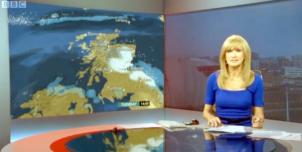Full Freeview on the Angus (Dundee City, Scotland) transmitter
| Google map | Bing map | Google Earth | 56.554,-2.987 or 56°33'15"N 2°59'15"W | DD4 0RQ |
The symbol shows the location of the Angus (Dundee City, Scotland) transmitter which serves 130,000 homes. The bright green areas shown where the signal from this transmitter is strong, dark green areas are poorer signals. Those parts shown in yellow may have interference on the same frequency from other masts.
_______
Digital television services are broadcast on a multiplexes (or Mux) where many stations occupy a single broadcast frequency, as shown below.
64QAM 8K 3/4 27.1Mb/s DVB-T MPEG2
H/V: aerial position (horizontal or vertical)
Which Freeview channels does the Angus transmitter broadcast?
If you have any kind of Freeview fault, follow this Freeview reset procedure first.Digital television services are broadcast on a multiplexes (or Mux) where many stations occupy a single broadcast frequency, as shown below.
64QAM 8K 3/4 27.1Mb/s DVB-T MPEG2
H/V: aerial position (horizontal or vertical)
Which BBC and ITV regional news can I watch from the Angus transmitter?

BBC Reporting Scotland 2.4m homes 9.2%
from Glasgow G51 1DA, 112km southwest (228°)
to BBC Scotland region - 230 masts.

STV News 0.2m homes 0.8%
from Dundee DD1 4QB, 11km south (177°)
to STV North (Dundee) region - 24 masts.
Are there any self-help relays?
| Glen Cova A | Active deflector | 40 km N of Dundee | |
| Glen Cova B | Active deflector |
How will the Angus (Dundee City, Scotland) transmission frequencies change over time?
| 1965-80s | 1984-97 | 1997-98 | 1998-2010 | 2010-13 | 2013-18 | 2013-17 | 27 Nov 2019 | ||
| VHF | C/D E | C/D E | C/D E | C/D E | C/D E T | W T | W T | ||
| C11 | ITVwaves | ||||||||
| C31 | com7 | com7 | |||||||
| C33 | SDN | ||||||||
| C34 | _local | ||||||||
| C36 | ArqA | ||||||||
| C37 | com8 | com8 | |||||||
| C39 | BBCA | ||||||||
| C42 | D3+4 | ||||||||
| C45 | BBCB | ||||||||
| C48 | _local | _local | _local | ArqB | |||||
| C49tv_off | ArqB | ArqB | |||||||
| C53tv_off | C4waves | C4waves | C4waves | D3+4 | D3+4 | D3+4 | |||
| C54tv_off | SDN | SDN | SDN | ||||||
| C55tv_off | com7tv_off | ||||||||
| C56tv_off | COM8tv_off | ||||||||
| C57tv_off | BBC1waves | BBC1waves | BBC1waves | BBCB | BBCB | BBCB | |||
| C58tv_off | ArqA | ArqA | ArqA | ||||||
| C60tv_off | ITVwaves | ITVwaves | ITVwaves | -BBCA | -BBCA | ||||
| C61 | ArqB | ||||||||
| C63 | BBC2waves | BBC2waves | BBC2waves |
tv_off Being removed from Freeview (for 5G use) after November 2020 / June 2022 - more
Table shows multiplexes names see this article;
green background for transmission frequencies
Notes: + and - denote 166kHz offset; aerial group are shown as A B C/D E K W T
waves denotes analogue; digital switchover was 4 Aug 10 and 18 Aug 10.
How do the old analogue and currrent digital signal levels compare?
| BBCA, D3+4, BBCB | 20kW | |
| SDN, ARQA, ARQB | (-3dB) 10kW | |
| com7 | (-6dB) 5kW | |
| com8 | (-6.1dB) 4.9kW | |
| Mux 1*, Mux 2*, Mux A*, Mux B* | (-7dB) 4kW | |
| Mux C*, Mux D* | (-10dB) 2kW | |
| Analogue 1-4 | (-23dB) 100W |
Local transmitter maps
Angus Freeview Angus DAB Angus AM/FM Angus TV region BBC Scotland STV North (Dundee micro region)Which companies have run the Channel 3 services in the Angus transmitter area
|
|
Is the transmitter output the same in all directions?
Radiation patterns withheldSaturday, 6 August 2011
Tam Whitelaw: Try looking in the 800-899 (usually 803) channel number range for an alternative STV.
| link to this comment |
Friday, 23 September 2011
S
Stuart12:23 PM
Regarding the North and Tayside opts, you get one or the other on channel 3, but the other NEVER shows up separately in the 800's.
Easiest way to get the Angus signal is to pull the aerial out and start a scan, plug the aerial in just before it gets to UHF channel 53 or about 2/3s of the way through. :-)
| link to this comment |
Wednesday, 28 September 2011
S
Stuart9:10 AM
Sorry I was incorrect above, some receivers do allow both to be present, others don't. My LG TV does, my Vestel-based PVR doesn't.
| link to this comment |
Friday, 21 October 2011
K
keith8:45 PM
is there any particular reason why i should receive only some channels and not others on certain muxes? e.g. receive COM6(arqB)on UHF61 and am missing 'yesterday' and 'flim4', while i can get '4music', 'VIVA' and others. likewise with COM4(SDN) on UHF54 i am missing '5*' and '5USA' but still get 'ITV3' 'QUEST' and others. i have rescanned the UHF channels manually but to no avail.
| link to this comment |
J
jb389:36 PM
keith: I realise you have already re-scanned etc, but have you carried out a factory re-set before carrying out a further re-scanning operation? (factory reset called default condition on some sets)
| link to this comment |
Saturday, 22 October 2011
K
keith9:47 AM
Kirkcaldy
jb38, just did a first time install and all programmes are now there, many thanks for your help! i found it a bit odd to be receiving some programmes and not others, if a whole mux was missing then i'd have been ok. thanks again for your help
| link to this comment |
keith's: mapK's Freeview map terrainK's terrain plot wavesK's frequency data K's Freeview Detailed Coverage
J
jb3812:39 PM
keith: Thanks for the update and pleased to hear all is OK now. Yes, its always best to start afresh by getting rid of any stored data that may have got corrupted during a previous procedure, because as you say it can be a bit mystifying to have programme channels missing when its known that they are all on the same multiplex.
| link to this comment |
Sunday, 23 October 2011
D
David Wall5:03 PM
Newport-on-tay
Do you have any explanation why the Angus transmitter is transmitting at 20 megawatts for the BBC channels and 10 megawatts for some of the ITV channels? Where we used to live in Sutton Coldfield, the local Sutton Coldfield transmitter is now digital and is putting out all TV channels on 200 megawatts (if I have interpreted the information correctly). So here we are at one tenth the power for the BBC channels and one twentieth the power for others.
| link to this comment |
David's: mapD's Freeview map terrainD's terrain plot wavesD's frequency data D's Freeview Detailed Coverage
J
jb387:20 PM
David Wall: Well the difference is basically due to the coverage area involved Vs the homes that exist between the two areas you mentioned, with Sutton Coldfield serving approximately 1.870.000 homes, whereas with Angus its only 130.000, the purely commercial interests that use these Mux's not being willing to pay the substantially higher running costs of operating a high powered multiplex due to the much lower level of estimated return that's liable to be made.
(i.e: Unlike the BBC etc aimed at providing a public service, these Mux's are purely a business venture)
| link to this comment |
Wednesday, 2 November 2011
S
Stuart2:03 PM
David Wall: You could argue that transmitters that serve major population areas are over-powered, it goes back to when the first TV transmitters were established, they were designed to cover the largest area possible with one mast, and with 405-line VHF signals they covered the country quite well. UHF signals don't travel so well and more transmitters were needed. Angus is really just a fill-in between Durris and Black Hill.
I never thought about the Watts per viewer argument, but it seems to make sense.
Another way to look at it: if 10kW can cover 95% (say) of viewers and 20kW can cover 99%, that's twice the cost to reach 4% more people, not worth it in commercial terms.
| link to this comment |
Select more comments
Your comment please!




